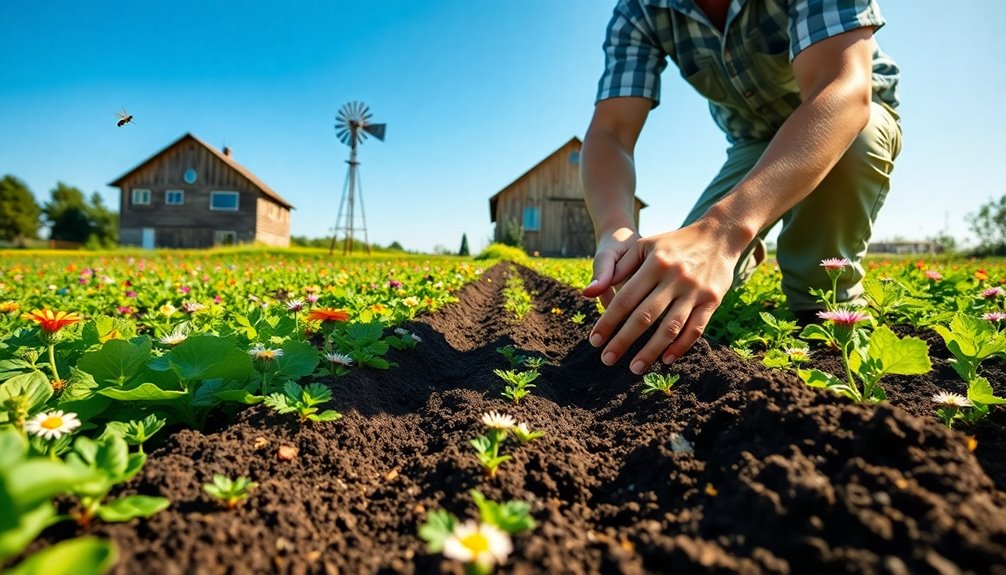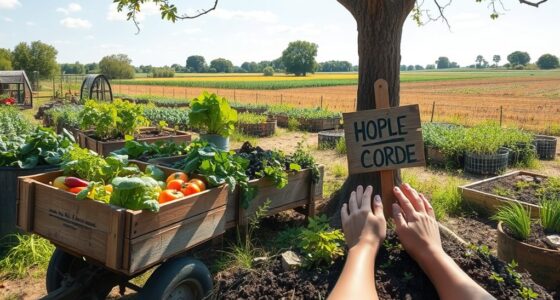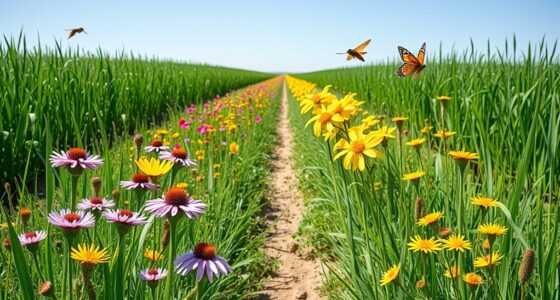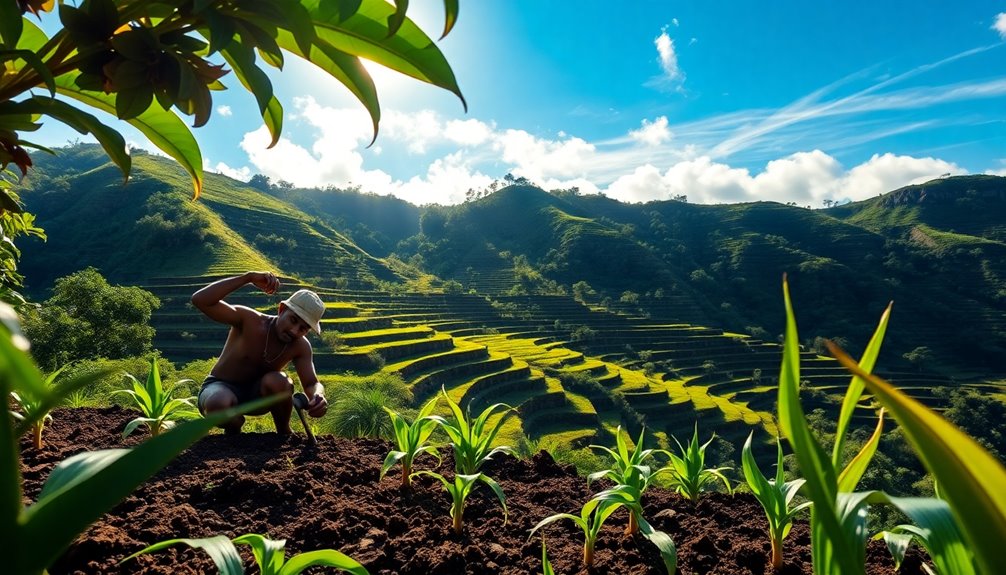Humans started farming around 12,000 years ago, marking a major shift from nomadic lifestyles. This change began in the Fertile Crescent with the domestication of crops like emmer wheat and barley. By 10,000 to 7,000 BCE, agriculture developed independently in at least 11 regions. The Neolithic Revolution led to permanent settlements and population growth, transforming societies. Domestication of animals such as goats and pigs also played a vital role. This significant change laid the groundwork for modern agriculture. If you're curious about how these practices evolved and their impact on cultures, stick around to uncover more!
Key Takeaways
- Agriculture began around 12,000 years ago, transitioning humans from nomadic lifestyles to settled farming communities.
- The Fertile Crescent is recognized as the origin of agriculture, with emmer wheat and barley domesticated around 9500 BCE.
- Independent agricultural development occurred in at least 11 regions by 10,000 to 7,000 BCE, including rice in southern China.
- The Neolithic Revolution facilitated population growth and the establishment of complex societies through agricultural surpluses.
- Domestication of key crops and animals supported the formation of settled communities and cultural advancements in early civilizations.
Historical Overview of Agriculture

Agriculture's emergence around 12,000 years ago marked a pivotal shift from nomadic hunter-gatherer lifestyles to settled farming practices. This change began in the Fertile Crescent, where the domestication of key crops like emmer wheat and barley laid the groundwork for modern agriculture.
By 10,000 to 7,000 BCE, independent agricultural development occurred in at least 11 regions globally, including northern China and Mesoamerica. The Neolithic Revolution, as it's known, spurred population growth and led to the establishment of permanent settlements.
As people settled, they cultivated the land, which further enhanced food production and community stability. This shift not only changed how societies functioned but also set the stage for the complex civilizations that would follow.
Neolithic Revolution and Its Impact

You'll see how the Neolithic Revolution transformed human life by shifting from nomadic lifestyles to settled agricultural communities.
This change not only created agricultural surpluses but also spurred societal growth and complexity.
As you explore these impacts, consider how these developments laid the groundwork for modern civilization.
Transition to Settled Life
The change to settled life, heralded by the Neolithic Revolution, transformed human societies around 12,000 years ago.
You witness a dramatic shift from nomadic hunter-gatherers to permanent settlements centered on agriculture. Early farmers cultivated wild crops like peas, lentils, and barley, while domesticating animals such as goats and wild oxen.
This shift provided a more reliable food supply, enabling population growth from about 5 million people 10,000 years ago to billions today.
With the advent of agriculture, complex societies began to develop, marked by social stratification and economic systems.
The Neolithic Revolution not only guaranteed food security but also laid the groundwork for trade and specialized labor, fundamentally changing the way humans lived and interacted.
Agricultural Surplus Development
As societies settled into a more stable way of life, agricultural surplus became a game changer in human history.
The Neolithic Revolution, beginning around 12,000 years ago, transformed early farmers from nomadic lifestyles to cultivating crops like emmer wheat and barley in the Fertile Crescent. This shift led to significant population growth as people established permanent settlements.
With the surplus food produced, communities could support larger groups, fostering the emergence of complex societies.
Innovations in farming techniques further increased crop yields, enabling trade and the development of economic systems.
Societal Changes and Growth
Transforming from nomadic lifestyles to settled farming communities, societies during the Neolithic Revolution experienced profound changes that reshaped human existence.
With the rise of agriculture, you witnessed an agricultural surplus that supported permanent settlements and led to a dramatic increase in global population. This shift allowed communities to sustain larger groups, fostering societal changes like social stratification and the emergence of complex societies.
As people settled, trade flourished, driving economic systems and cultural advancements. The Neolithic Revolution not only changed how you produced food but also laid the groundwork for cities and specialization of labor, ultimately creating disparities in wealth and power.
The impacts of this transformative era continue to influence human societies today.
Key Crops and Their Domestication
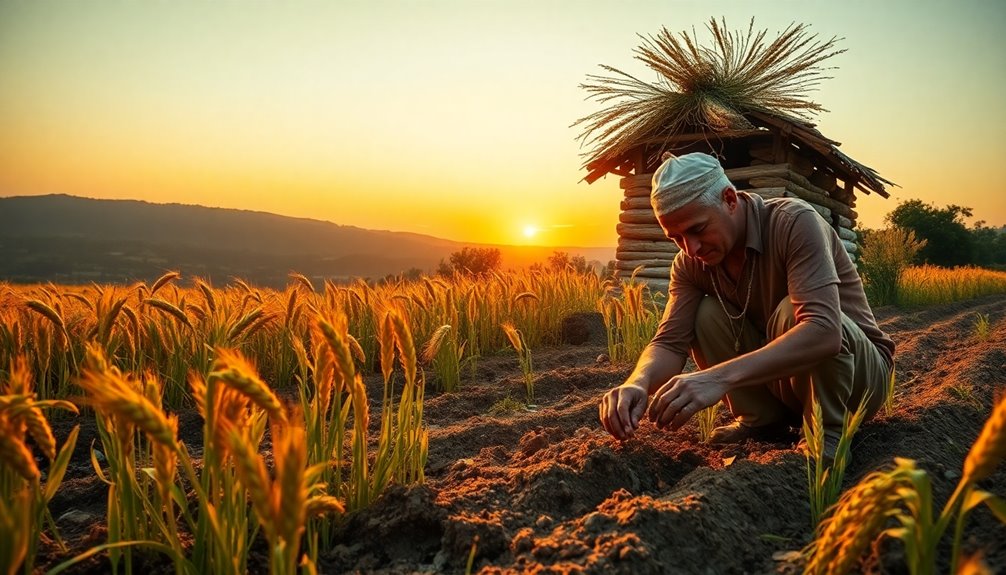
Agriculture's roots can be traced back to the domestication of key crops that shaped early human societies. In ancient regions like the Levant, emmer wheat and barley were cultivated by 9500 BCE, marking a significant leap in agriculture.
Meanwhile, rice was domesticated in southern China between 11,500 to 6200 BCE, providing a staple that supported population growth in East Asia.
In southern Mexico, maize evolved from teosinte around 6700 BCE, becoming essential for Mesoamerican civilizations. The New World also saw the domestication of crops like potatoes, tomatoes, and squash around 8000 BCE.
Domestication of Farm Animals
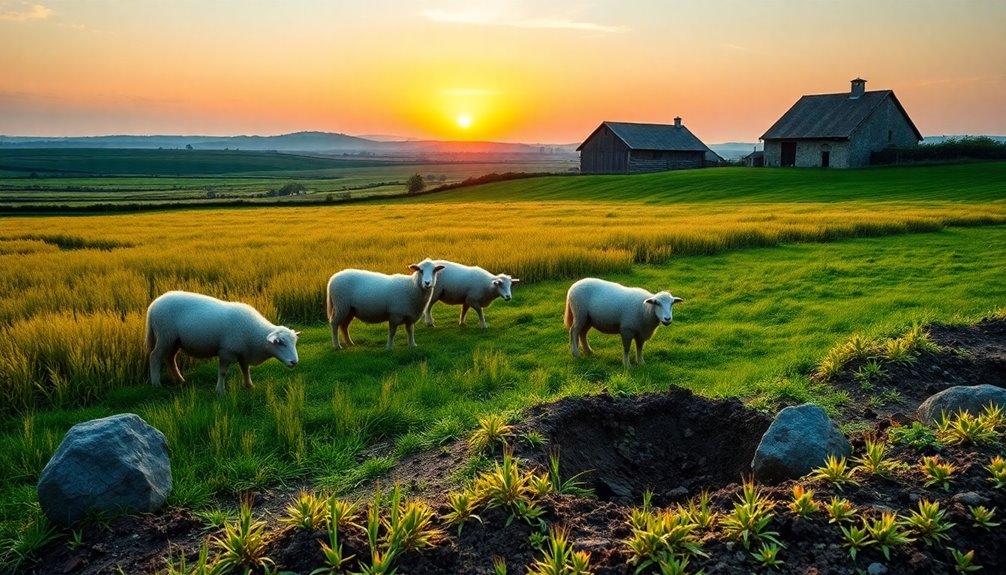
The domestication of farm animals played an essential role in the development of early agricultural societies. Around 13,000 years ago in the Fertile Crescent, humans began to domesticate animals like goats, sheep, and pigs, which became crucial for farming.
By 10,500 years ago, cattle were also domesticated, providing meat, milk, and labor in Mesopotamia. Through selective breeding, people enhanced desirable traits in livestock, creating a genetic divergence from their wild relatives. This process considerably influenced agricultural practices and diets, particularly with the rise of lactose tolerance in northern Europeans.
Agricultural Innovations Through Time

As you explore agricultural innovations through time, you'll see how technological breakthroughs have reshaped farming practices.
From the introduction of mechanized tools to sustainable methods developed over centuries, each advancement has played an essential role in enhancing productivity and environmental care.
These innovations not only transformed how food is produced but also how we interact with the land.
Technological Breakthroughs in Farming
Throughout history, advancements in farming have dramatically shaped food production and societal development.
Technological breakthroughs like the introduction of synthetic fertilizers in the early 1900s transformed agriculture by converting atmospheric nitrogen into ammonia, boosting crop yields considerably.
The Green Revolution, beginning in the mid-20th century, further revolutionized food production through high-yield crop varieties and advanced farming techniques, especially in developing nations.
Innovations from the Bronze Age, such as irrigation canals, ploughs, and crop rotation, enhanced agricultural efficiency in ancient civilizations.
Additionally, mechanization during the British Agricultural Revolution brought machinery like seed drills and threshing machines, increasing efficiency and scale.
Together, these advancements have paved the way for modern farming, ensuring a more reliable food supply for growing populations.
Sustainable Practices Over Centuries
Agriculture has evolved considerably over centuries, blending traditional wisdom with innovative practices to promote sustainability.
You'll see that sustainable practices, like crop rotation and intercropping, have long been essential for maintaining soil fertility and enhancing ecological balance. These methods help reduce pest populations and guarantee healthier crops.
While the Green Revolution introduced high-yield varieties to bolster food supply, it also sparked environmental concerns. Innovations in irrigation, like drip and sprinkler systems, have increased water efficiency, addressing resource scarcity.
In recent decades, organic farming has gained traction, emphasizing natural inputs and ecological processes. This shift reflects a rising awareness of health impacts tied to conventional agriculture, proving that blending tradition with innovation can lead to a sustainable future. Additionally, the adoption of energy-efficient technologies in agriculture, such as heat pumps, can further enhance sustainability by reducing energy consumption and greenhouse gas emissions.
Population Growth and Food Security

The dramatic rise in global population—from 1.6 billion in 1900 to over 7 billion by 2011—has put immense pressure on food systems worldwide.
As the population grew, advancements in agriculture allowed food supplies to expand greatly, even producing enough to feed an extra 1.6 billion people by 2012.
Yet, hunger persists due to the uneven distribution of food and the staggering waste in supply chains. Critics argue that agriculture may be the worst mistake humans made, raising concerns about sustainability.
While modern innovations have boosted production, they haven't solved the fundamental issue of access.
Historical debates echo today, with fears that unchecked population growth could outstrip food production, highlighting the ongoing struggle for food security in an ever-growing world.
Environmental Consequences of Farming

Farming's environmental consequences are profound and far-reaching, affecting ecosystems and human health alike. The heavy reliance on synthetic fertilizers has boosted crop yields but caused soil degradation and nutrient runoff, polluting nearby water sources.
Monoculture practices reduce biodiversity, leaving crops more vulnerable to pests and diseases. Historical famines in Europe illustrate the environmental limits of farming, exacerbated by mismanaged agricultural practices.
Additionally, agriculture's expansion contributes to climate change, as deforestation and land conversion release greenhouse gases and disrupt local ecosystems.
This shift to farming has also led to health declines, with increased carbohydrate consumption linked to malnutrition and higher disease prevalence in early communities.
Understanding these impacts is vital for sustainable agricultural practices moving forward.
Cultural Transformations and Agriculture

Shifting from nomadic lifestyles to settled farming communities transformed human culture in profound ways. The change to agriculture, known as the Neolithic Revolution, allowed for permanent settlements and the domestication of animals, creating more reliable food sources. As farming spread, it led to agricultural surplus, which facilitated social stratification and complex economic systems.
| Aspect | Before Agriculture | After Agriculture |
|---|---|---|
| Lifestyle | Nomadic hunter-gatherers | Permanent settlements |
| Food Sources | Wild plants and animals | Cultivated crops & livestock |
| Social Structure | Egalitarian | Social stratification |
| Cultural Practices | Rituals of survival | Feasting & religious rituals |
These changes not only influenced survival but also the emergence of new cultural practices, shaping the evolution of human societies.
Future of Agriculture and Sustainability
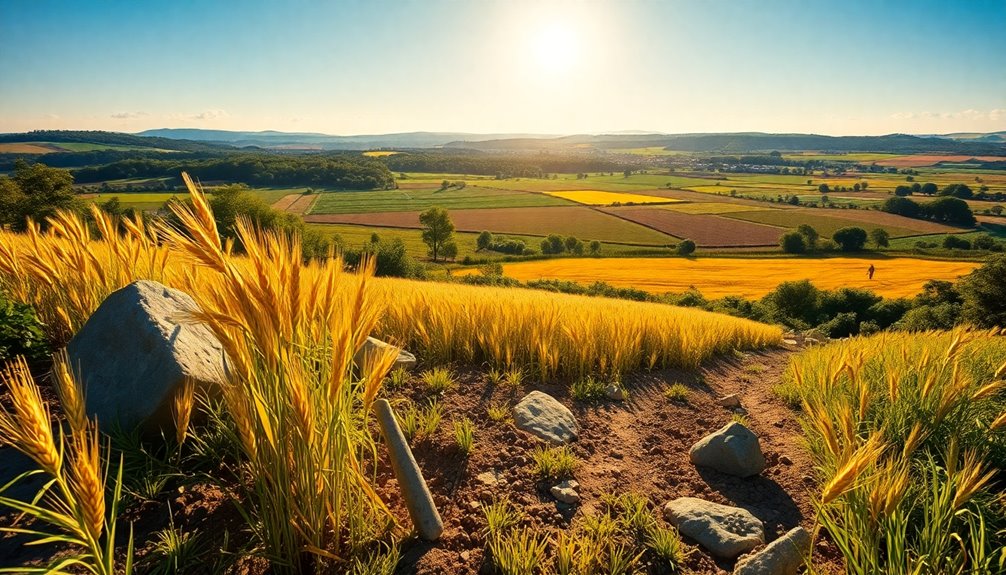
Agriculture has come a long way since the Neolithic Revolution, and its future hinges on sustainability.
You'll see that sustainable agricultural practices, like crop rotation and organic farming, enhance soil health and biodiversity. Innovations in technology, such as precision farming and GMOs, aim to boost food production efficiency while cutting down on resource inputs.
As the world shifts towards plant-based diets, you can contribute to lowering greenhouse gas emissions and improving food sustainability.
However, climate change presents challenges, compelling us to adopt drought-resistant crops and sustainable water management strategies to guarantee food security. Additionally, integrating solar-powered irrigation systems can significantly enhance crop yields and efficiency, supporting sustainable agricultural practices.
Frequently Asked Questions
When Did Humans First Discover Agriculture?
You might wonder when humans first discovered agriculture.
It all started around 12,000 years ago when people shifted from nomadic lifestyles to farming. The earliest signs of plant domestication, like peas and barley, emerged around 9500 BCE in the Fertile Crescent.
As climates changed after the Ice Age, they found fertile ground for growing crops, and this led to the independent development of agriculture across various regions worldwide.
When Did the Agricultural Era Start?
Imagine a world where the sun rises over fields of golden wheat, marking the dawn of the agricultural era around 12,000 years ago.
You witness a profound shift as nomadic lifestyles give way to settled farming communities. Starting in regions like the Fertile Crescent around 9500 BCE, you see early farmers cultivating crops like emmer wheat and barley, paving the way for complex societies and permanent settlements that reshape human existence forever.
What Region Around 10,000 Years Ago Did People Start to Learn Agriculture?
Around 10,000 years ago, people in the Fertile Crescent began learning agriculture.
This region, encompassing modern-day Iraq, Jordan, and Turkey, was where early farmers cultivated wild grains like emmer wheat and barley.
You'd see them shifting from foraging to farming, experimenting with crops and domesticating animals such as goats.
These developments spurred significant societal changes and laid the foundation for complex interactions among diverse groups, spreading agricultural practices far and wide.
What Is the Earliest Evidence of Agriculture?
Imagine a world where the first seeds were sown, transforming wild landscapes into cultivated fields.
The earliest evidence of agriculture shows up around 12,000 years ago in the Fertile Crescent, where emmer wheat and barley flourished.
You'll find traces of small-scale cultivation as far back as 21,000 BCE at Ohalo II in Israel.
This marks humanity's leap from foraging to farming, forever changing the course of societies and our relationship with the land.
Conclusion
As you wander through the rich tapestry of farming's history, you realize it's more than just planting seeds in soil; it's a vibrant dance of life. From the first domesticated grains swaying in the breeze to the bustling markets filled with colorful produce, agriculture has shaped our world. Embracing innovation and sustainability, you stand at the crossroads, ready to cultivate a future where harmony with nature blooms, ensuring that the earth remains fertile for generations to come.



